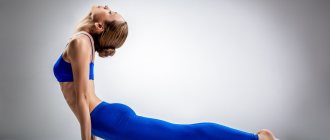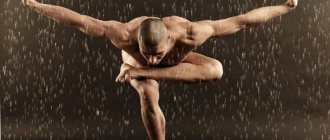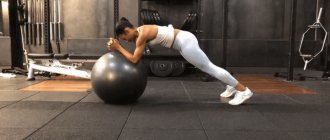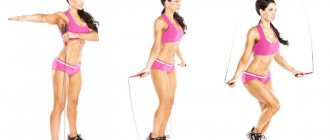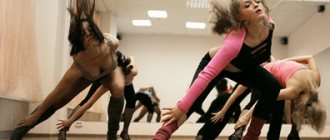We sit, walk, run, perform complex physical exercises, without thinking about what keeps us in balance and controls the position of our body in space.
Fitness trainer Anna Yuskina talks about the mechanisms that underlie the most important skill - the ability to maintain balance and what exercises will help develop it.
Fitness trainer Anna Yuskina
There are exercises that help build muscles, increase strength and endurance. There is also a special group of exercises for training your sense of balance. What ultimately helps you become strong, resilient, flexible, and dexterous... This is the base on which everything else is built.
All processes in the body depend on the ability to maintain balance, from the functioning of the nervous system, musculoskeletal, vestibular apparatus and ending with psychological well-being.
It would seem such a simple skill, but how important it is!
80% of unsuccessful falls are a consequence of an undeveloped sense of balance. Once you turn on the right mechanism in time, balance will be restored. Simple daily workouts help trigger an internal stabilizer, which will protect you from everyday bruises and more serious injuries.
What do balance exercises do?
It would seem that balance is an extra ability of the body for those who keep the body in good shape. But for those who engage in outdoor games, train endurance, engage in tourism and hiking, or any extreme sports, maintaining balance is the initial task. After all, most movements are not aimed at isolated muscle work, but at the holistic, cohesive work of the musculoskeletal system to prevent many injuries, and in general to overcome certain difficulties.
It is important not only for athletes to maintain balance, but for everyone without exception. For what? I’ll explain with a simple example of maintaining balance on ice in winter weather. Exercises that develop balance can work the deep muscles that are responsible for stabilizing the skeleton. As for the ice surface, trained deep muscles are able to overcome this obstacle without the threat of falling.
Where to buy a balance board and how much does it cost?
On the manufacturer's website.
The simple design of the balance board makes it easy to manufacture. Balance boarding enthusiasts create their own brands and open their own stores. Prices are lower than those of simulators from the USA and Europe, and some companies produce balance boards with individual designs. You can paint the board yourself, such models cost from 2000 ₽, or buy a premium version for 8000 ₽. Backlit balance boards cost from 10,000 ₽
Shop of the manufacturer of balance boards Elements Balance boards with backlight from the manufacturer TREEKIX Moscow manufacturer of balance boards Bear Balance
In popular online stores.
Large selection of balance boards from different manufacturers and convenient delivery. You can choose based on reviews. The simplest models cost about 2000 ₽.
Balance boards on Ozone Balance boards on Wildberries
From hand.
If you don’t want to overpay or are afraid to give up your new hobby soon, buy a balance board from your own hands. You can find such a simulator on Avito for 1000 ₽.
Balance board in Moscow on Avito
A set of balance exercises
Below are exercises that involve all muscle groups. Anyone can choose a complex for themselves, even for home training without equipment, or if they have equipment that complicates the task.
Balance exercises without equipment
Balance on one leg
Let's start with the simplest exercise and a way to test balance in general. For those who have weak vestibular apparatus and muscles, this technique is quite suitable for a start. Also, this is a test of the level of preparation for maintaining balance, because many will not be able to complete this option.
- Stand straight, place your hands on your waist or sides.
- Maintaining your spinal axis, lift one leg in front of you as high as you can without leaning back.
- To make balance more difficult, you can raise your arms in front of you.
- Thus, you should maintain balance on both legs for as long as possible. For starters, from 30 to 60 seconds.
Martin
Performing this exercise is not so difficult at first glance. But the control of your body in this position will indicate the level of your skill and preparation. Many people are familiar with this technique from school, but not everyone did it correctly. The difficulty of the swallow is not so much in balance, but in aligning the line of the body and joints in the correct position.
- Stand straight, place your feet together, toes pointing forward.
- Raise your arms above your head, keep your back straight, tensing your abdominal muscles, thereby stabilizing the position of your spine.
- Slowly tilt your torso forward, simultaneously lifting your foot off the floor, lower your arms in line with your torso.
- Stop in a position where your arms, legs and torso form a straight line parallel to the floor. The supporting leg should always be straight at the knee.
- The important thing here is to align the hip joint. You can navigate by the ilia, which should be in the same plane, that is, the pelvis should not fall to one side. This is a very important point.
- It is also important to keep your neck straight, stretching the crown along with the spine.
- Maintain the pose for as long as you can with proper technique. Then repeat on the other leg.
Tree
Another common balance exercise from yoga. It is not as difficult in balance as in the joint alignment technique. Therefore, it is suitable for beginners who still have poor balance.
- Stand straight, lift one leg, placing your foot with the help of your hands on the adductor (inner) surface of the supporting leg, the toe of which faces forward.
- The closer the heel to the groin, the more difficult it is. Accordingly, to simplify the technique, you can lower the heel closer to the knee (it all depends on the mobility of the joints).
- To make balance easier, the arms can be joined together at chest level. To complicate the pose, according to the rules of the pose, straight arms are connected at the top above the crown.
- When performing the technique, it is important to move the bent knee to the side, thereby opening the pelvis and making balance more difficult.
- Hold the pose motionless for as long as possible, then switch to the other side.
Plank with emphasis on one arm and leg
The exercise is performed in a static position, like the previous ones. To perform it, you can stand either on your forearm or on your straight arms. A very simple option is to rest on the knee. Here, choose for yourself, based on the physical capabilities of your body.
- Standing in a plank position, raise one arm straight in front of you and the opposite leg straight at the knee. If there is discomfort in your hand, lower yourself onto your forearm.
- Hold the position as long as possible, trying not to sway.
- Repeat on the second side for the same amount of time.
Gun
This option is suitable for a high level of physical fitness, so if the body is ready for such techniques, then why not develop balance with it. To make it easier, you can hold on to a support, TRX loops, or a chair.
- Choose the depth of the squat yourself. The main task is to squat on one leg, maintaining balance, and not touching the floor with your front leg.
- Perform as many repetitions as possible, but with proper technique. Repeat on the other leg.
Exercises to develop balance with fitness equipment
Leg raise while sitting on a fitball
Let's start with the simplest option. Here, balance is achieved by keeping the body in one position while sitting on the ball. It is performed dynamically, but you can also keep the pose static.
- Sit on a ball that is suitable for your height (knee angle – 90 degrees). Read more about choosing a fitball →
- Place your feet hip-width apart, parallel to each other.
- Keep your arms straight up, palms facing each other.
- Without leaning back or to the sides, straighten the knee of one leg in front of you while lowering your arms in front of you, staying on a line parallel to the floor.
- When straightening your knee, you should maintain balance.
- Then return your leg and arms to the starting position, and repeat on the other leg.
Plank, hands on fitball
A complicated version of the plank, in which an unstable position is achieved by resting your hands on the ball (palms or forearms).
- Place your palms on the ball shoulder-width apart, then gradually step your feet back, forming a plank. It is important to immediately maintain your balance so as not to fall to the sides.
- The line of the entire body should be perfectly straight, the main goal is to maintain this position for as long as possible.
Plank, feet on fitball
The reverse version of the previous exercise, when the hands rest on the floor and the legs are placed on an unstable surface. The same can be done on an inverted boss.
- Place your palms on the floor under your shoulder joints.
- Then place your feet on the ball at a short distance from each other (approximately the width of your pelvis).
- Tighten your stomach while maintaining your spine.
- Stand in plank position for as long as possible.
Barefoot squats
To begin with, master the variation in the usual bosu position, then you can turn it over.
- Place your feet barefoot, hip-width apart.
- Slowly squat parallel to the floor, maintain balance.
- Then straighten your torso smoothly.
Variation of squats on an inverted barefoot.
Medicine ball push-ups
The exercise can also be performed on a barefoot or fitball. Choose the appropriate level of difficulty; to start, you can do push-ups from your knees.
- Place the balls wide (wider than shoulder width) with your palms on them.
- Keep your torso straight, without arching your lower back.
- As you inhale, slowly, without losing your balance, bend your elbows and lower yourself lower to the floor.
- Exhale and do push-ups.
Oblique lunges
With your legs moving to the sides, it is more difficult to maintain balance (Photo: womond.com)
A variation of backward lunges. They help strengthen the buttocks and tighten the hips in the “ear” areas. How to do it:
- Stand up straight, keep your hands clasped in front of you.
- Take your leg back and cross it (right leg to the left, left leg to the right). The front leg bends at a right angle.
- Return to the starting position and repeat for the other leg.
To make it more challenging, add swings. After returning to the starting position, swing your working leg three times to the side.
What other exercises do you know for coordination of movements? Share in the comments.
Recommendations for training and balance development
- Never rush when performing balance exercises, otherwise you may end up with injury rather than benefit.
- You should train your balance no more than 3 times a week.
- You can combine such training with strength training.
- The duration and quantity of one exercise is selected independently, start with 30 seconds, gradually increasing the duration and level of difficulty.
- The main thing is not time and quantity, but technique and stability.
Gradually increasing the difficulty
It is better to start training with 6-8 vestibular exercises. The number of approaches can be increased weekly (up to 15-20). After mastering the entire gymnastic complex, it is gradually complicated:
- Perform the same tasks with eyes closed;
- Exercise on a soft surface - pillows, mattresses, blankets;
- They narrow the area of support - for example, use a balancing mat;
- Add weights - dumbbells, kettlebells, heavy vests.
Complicate the training step by step only when you have completely mastered the previous step. Forcing things too actively can lead to injury.
Note!
It takes at least 3 months for a lasting improvement in balance, although you will feel the first changes after 2-3 weeks of regular exercise.
Natarajasana (King of Dancers Pose)
A very common and beautiful pose. It strengthens the leg muscles well, visually lengthens the thighs, groin and abdomen, and calms the nerves. But this exercise is contraindicated for those who have high or low blood pressure, injuries to the legs, spine, hips, etc., or acute kidney and lung diseases.
- Get into mountain pose. Bend your right knee and grab the inside of your ankle or shin with your right hand and shift your weight to your left leg.
- Slowly, if possible, move your raised leg back, try to raise it as high as possible, while simultaneously extending your left arm.
- The body is in front, the back bends. If the exercise is too difficult for you, the supporting leg can be bent at the knee. Repeat the exercise, alternating legs;
Vrikshasana (tree pose)
You can still learn from a tree its endurance, calmness, strength and power. You can do this right now! Why put everything on hold? The same “tree” pose will allow you to learn coordination of movements, give flexibility to your body and confidence in yourself and your strengths.
This is a yoga pose for mental balance and tranquility.
- To perform the exercise, stand straight with your feet together, then bend your right leg at the knee and rest your foot on the thigh of the other leg.
- You need to raise your hands up, clasping them with your palms facing each other. The body should resemble an elongated string.
- Like the treetops, reach upward. At this point, your base of support is your left leg.
Do not forget that the asana must be repeated on the other leg. Girls sometimes involuntarily stand in this position while doing household chores - peeling potatoes, washing dishes, etc. And this is a very wonderful practice!;
Crow Pose
This pose allows you to adjust balance on your arms in yoga and tones your abdominal muscles.
- To perform it, you need to lower yourself into a deep squat, so that your pelvis almost touches the floor.
- Place your palms slightly wider than your shoulders and place them on the floor. Leaning on your palms, bending your elbows, slowly lift your pelvis up.
- Resting your knees on your hands, gradually lift your legs off the floor. Maintain balance by leaning forward slightly and straightening your elbows.
Virabhadrasana (weasel pose)
Thanks to this pose, the muscles of the legs will be strengthened, and the flexibility of the spine, lower back and neck will develop.
- To begin, stand up straight with your feet together. Then inhale and hold your breath.
- At this time, raise your straightened arms up and move them to the sides, while simultaneously moving your right leg back as far as possible.
- Pull your body up, tensing your abdominal muscles. Then stand on your toes and stand as long as you can.
- Continue the exercise, alternating legs;
Pincha mayurasana (Wall stand on forearms)
The name of this pose was associated with the raised fan-tail of a peacock in rainy weather. This asana is quite difficult to perform, but it guarantees inhibition of the aging process of the body, improves blood circulation and metabolism.
- To perform the exercise, stand with your back to the wall at a distance of one step.
- Then you need to sit down with your palms in front of you.
- With your feet pressed against the wall, straighten your back.
- After this, you need to straighten your legs so that they create parallel to the floor.
- Then lower your forearms to the floor and hold this position as long as possible.
Vyagrasana (tiger pose)
This asana is an excellent exercise machine for the back and spine. It tones the abdominal organs, calms the nervous system, and reduces excess fat on the hips and buttocks.
- Get on all fours and, without straightening your right leg at the knee, lift it up.
- The ankle of the right leg should be grasped with the opposite hand.
- In this position, the weight is transferred to the opposite arm and leg.
- Imagine yourself as a strong and powerful tiger and concentrate your attention on the objects in front and below.
- Continue the exercise, alternating sides.
If you are an advanced yogi, you can try the following exercises:



